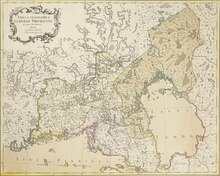Vyborg Governorate
This article needs additional citations for verification. (June 2024) |
| Vyborg Governorate Выборгская губерния | |||||||||
|---|---|---|---|---|---|---|---|---|---|
| Governorate of the Russian Empire | |||||||||
| 1744–1812 | |||||||||
 | |||||||||
| History | |||||||||
• Established | 1744 | ||||||||
• Disestablished | 1812 | ||||||||
| |||||||||
| Today part of | Finland Russia | ||||||||

Vyborg Governorate[a] was an administrative-territorial unit (guberniya) of the Russian Empire. It was established in 1744 in newly ceded territories from Sweden following the Treaty of Åbo and parts of Saint Petersburg Governorate which were previously ceded by Sweden in 1721 as a result of the Great Northern War.
In the Treaty of Nystad of 1721, Sweden formally ceded control of parts of the Viborg and Nyslott County and the Kexholm County located on the Karelian Isthmus and Lake Ladoga region to Russia. First these areas were part of the Saint Petersburg Governorate. Vyborg Governorate was established in 1744 when Sweden ceded control of parts of Kymmenegård and Nyslott County (which had been parts of Viborg and Nyslott County prior to the Treaty of Nystad) by the Treaty of Åbo. In Sweden (including Finland), the area of the governorate was also known as Old Finland (Swedish: Gamla Finland, Finnish: Vanha Suomi), and between 1802 and 1812 it was named the "Finland Governorate".

Initially the governorate had subdivision into three provinces: Saimaa Province, Vyborg Province and Kexholm Province, which reflected the previous borders of the Swedish counties (part of Kymmenegård and Nyslott County ceded in 1743, part of Viborg and Nyslott County ceded in 1721 and part of Kexholm County ceded in 1721, respectively). Catherine the Great issued a decree in 1775 to change the previous administrative division from governorates to viceroyalties (namestnichestvo), and in 1783 the Vyborg Governorate was renamed into Vyborg Viceroyalty (Russian: Выборгское наместничество, romanized: Vyborgskoye namestnichestvo, however in Finnish the name did not change) within its previous borders. The subdivision was also changed, from provinces into uyezds (Russian: уе́зд, Finnish: kihlakunta), of which there were 6 in the viceroyalty: Wilmanstrand, Vyborg, Friedrichshaven, Nijschlott, Kexholm and Serdobol.[b] Paul I changed the name back to Vyborg Governorate in 1796, renaming the previous uyezds into districts (German: Lands Kommissariat, Russian: округ, romanized: okrug, Finnish: kihlakunta)[1] and Alexander I changed the name to Finland Governorate in 1802.
During the Napoleonic Wars, the Kingdom of Sweden had allied itself with the Russian Empire, United Kingdom and the other parties against Napoleonic France. However, following the Treaty of Tilsit in 1807, Russia made peace with France. In 1808, and supported by France, Russia successfully challenged Swedish control over Finland in the Finnish War. In the Treaty of Fredrikshamn on September 17, 1809, Sweden was obliged to cede all its territory in Finland, east of the Torne River, to Russia. The ceded territories became a part of the Russian Empire and was reconstituted into the Grand Duchy of Finland, with the Russian tsar as the grand duke.
In 1812, the area of Vyborg Governorate was transferred from Russia proper to the grand duchy and established as Viipuri Province. The transfer, announced by Tsar Alexander I just before Christmas, on December 23, 1811 O.S. (January 4, 1812 N.S.), can be seen as a symbolic gesture and an attempt to appease the sentiment of the Finnish population, which had just experienced Russian conquest of their country by force in the Finnish War.
Governors
[edit]- 1744–1744 Yury Nikitich Repnin
- 1745–1752 Afanasey Isakov (acting)
- 1752–1754 Johann Christoph von Keyser
- 1754–1766 Afanasey Isakov
- 1766–1778 Nikolaus Hendrik von Engelhardt
- 1779–1780 Yevgeny Petrovich Kashkin
- 1780–1782 Pyotr Alekseyevich Stupishin
- 1782–1785 Wilhelm Heinrich von Engelhardt
- 1785–1785 Alexander Magnus von Peutling
- 1785–1793 Karl Johann von Günzel (acting)
- 1793–1797 Fyodor Pavlovich Shcherbatov
- 1797–1799 Karl Magnus von Rüdinger
- 1799–1799 Pyotr Vasilyevich Zheltuhin
- 1799–1804 Magnus Orraeus
- 1804–1808 Nikolay Fyodorovich Emin
- 1808–1811 Ivan Jakovlevich Buharin
- 1811–1812 Johan Gustaf Winter
References
[edit]- ^ Berendts, Eduard Nikolaevich (1903). Лекции по административному праву Великого княжества Финляндского [Lectures on administrative law of the Grand Duchy of Finland] (in Russian). R. Golkike and A. Vilborg.


 French
French Deutsch
Deutsch